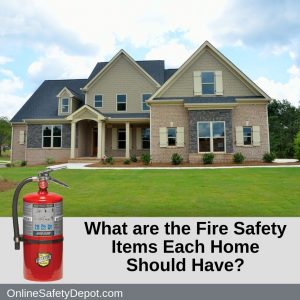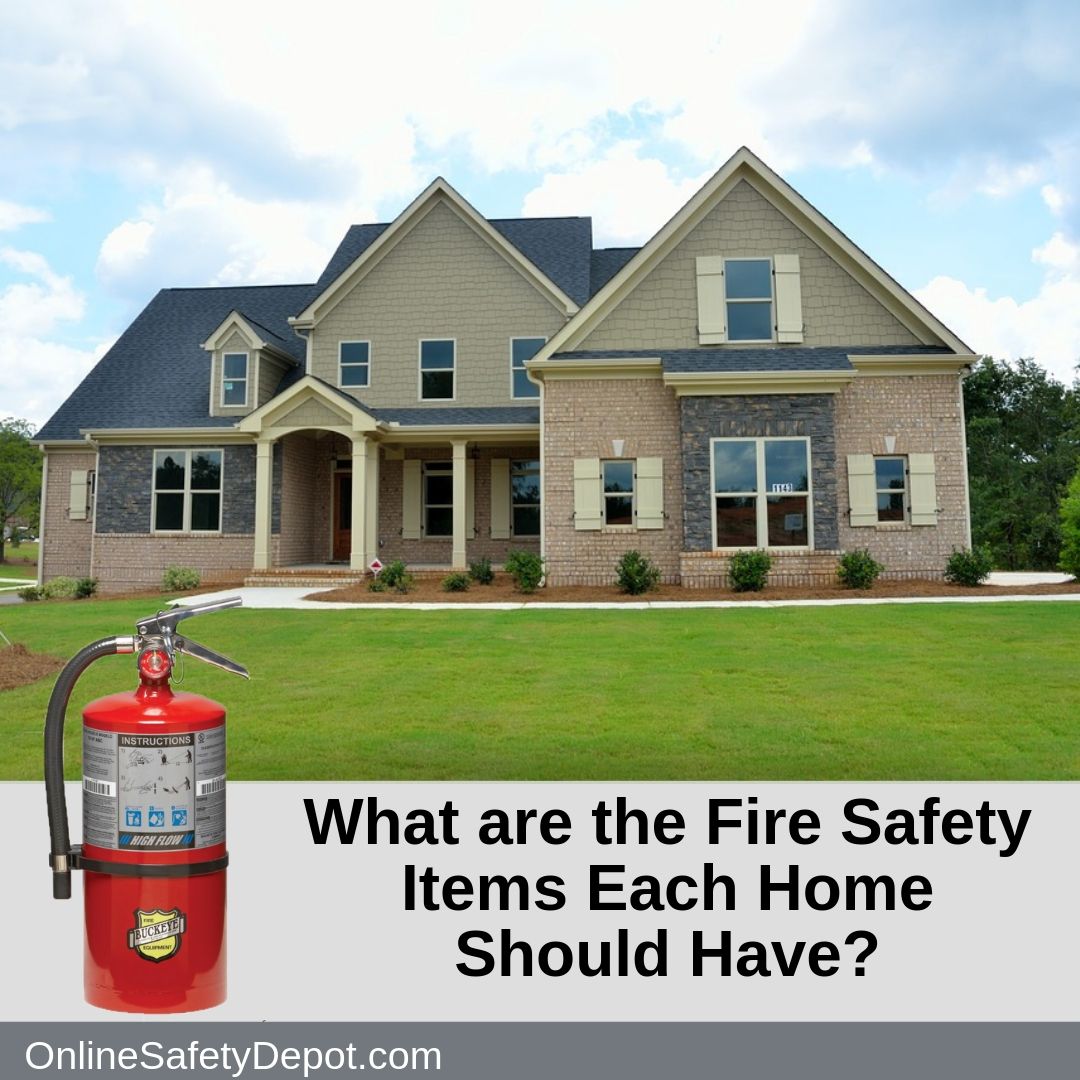What are the Fire Safety Items Each Home Should Have?
 Sustaining burns or dying in a fire, or watching your home destroyed by fire is reported to be one of the most terrifying and devastating events a person can experience. Of all the civilian deaths that occur by fire each year in the United States (approx. 2,500), 78% of those deaths occur in home structure fires, and 71% of all civilian injuries by fire (approx. 13,00 annually) occur from home fires.
Sustaining burns or dying in a fire, or watching your home destroyed by fire is reported to be one of the most terrifying and devastating events a person can experience. Of all the civilian deaths that occur by fire each year in the United States (approx. 2,500), 78% of those deaths occur in home structure fires, and 71% of all civilian injuries by fire (approx. 13,00 annually) occur from home fires.
So, when considering a home fire safety program, what are the important fire safety items that every home should have? Each home should have properly installed and functioning smoke detectors, carbon monoxide alarms, appropriate type or class fire extinguishers, fire blankets, fire escape ladders, exterior water accessibility, and a well-planned and written fire emergency and escape plan.
Let’s examine each of these individually as to the important role they plan in a home fire safety program.
Smoke Detectors. Properly installed and working smoke detectors provide early warning of a fire in your home and have shown to decrease the risk of dying from or being injured by fire. National guidelines mandate that newly built homes have smoke detectors installed in all levels of a home, outside each sleeping area, and inside each bedroom. The smoke detectors are to have both hardwire interconnection (if one detector is triggered then all sound the alarm) and be supported with battery backup should electricity not be working.
Carbon Monoxide Alarms. The incomplete combustion of wood, coal, gas, oil and some other fuel sources can produce carbon monoxide, an odorless, colorless, and tasteless and consequently an undetected gas that can be lethal at certain amounts. This same incomplete combustion of fuels commonly used to run home appliances such as water heaters, central heating systems, cookers, and boilers. These devices are therefore also a part of an early warning system of a home safety program.
Fire Extinguishers. There are a variety of types of classes of fire extinguishers available to combat fires of different fuel sources. It is recommended that every home have a fire extinguisher in the kitchen, garage, and workshop if applicable. In the kitchen where the type of fire that is likely to occur is one that involves a fuel used in cooking such as vegetable oil, animal fat, and grease. These types of fires are best extinguished using a Class K fire extinguisher with a mono-ammonium phosphate agent. The other recommended home fire extinguisher is a dry chemical Class ABC fire extinguisher. This multi-purpose fire extinguisher contains an extinguishing agent designed to effectively combat fires fueled with ordinary combustibles like wood, paper, trash, and clothes; flammable liquids like gas, oil, solvents, alcohol, and lacquers; and energized electrical fires caused by short-circuiting machinery, overloaded electrical cables, and outlets.
Fire blankets. Made of fire-retardant material, a fire blanket can be used to 1) smother a small kitchen fire of burning grease or oil, 2) wrap around an individual who must escape a fire area by reducing the heat they will be exposed to or to prevent their clothes from catching fire, and 3) smother the flames of individual whos clothes who are on fire.
Fire Escape Ladders. If a fire is blocking an escape path, then a window escape may be the only and best option available. Fire escape ladders can be mounted below window frames or stored in a bedroom closet. While they are certainly indicated for two and three level homes, they can also be useful and make a difference in a single-story home when descending from the window may be difficult for an individual with physical limitations.
Exterior Water Accessibility. While a 911 phone call to summon emergency personnel is one of the first things to do when safely away from fire danger, your ability to fight a home fire with your own water hoses until the fire department arrives is important and can help reduce the amount of structural damage as well as give you the option (and maybe peace of mind) to engage in trying to put out the fire yourself. Having exterior water faucets on the front and back of your house gives you this option regardless of where in the house the fire is located. It is also helpful to have a water faucet located a distance from the house, like in a garden area, to also use in combating a fire or for soaking nearby structures in the hope to prevent them from catching fire.
Fire Emergency and Escape Plan. Every home should have a well-planned, written out (including maps, diagrams, icons) fire emergency and escape plan that is reviewed and rehearsed on a consistent basis, ensuring that each member of the household knows his or her responsibilities and can effectively execute them. Specifically, the emergency plan should include the following:
- An emphasis on what is more important. Safely escaping from a fire is the first and most important task of every family member, not saving a property or personal belongings.
- Emergency 911 number. This nationwide emergency number should be big and bold and placed near the top of the page to emphasize its importance in the case of an emergency after all have been safely evacuated.
- Locations of fire extinguishers, fire blankets, and fire ladders. Whether these items be highlighted for location on a map of the house or their location explained in written form, each family member should know exactly where these important fire safety items are located. Of course, only those mature enough to be instructed in their use and physically capable of handling a fire extinguisher would be expected to use them.
- Escape routes. Escape routes should be known for each bedroom and other areas of gathering within the home. A map of each level of the house is helpful to help individuals see the path they should take to escape. Some families choose to have an escape route map prominently placed in the bedroom of each child.
- Navigating through smoke-filled areas. Train family members in how to effectively navigate escape routes that may be filled with smoke – dropping to your knees and crawling on all fours helping to reduce the inhalation of smoke.
- The Stop, Drop, and Roll Technique. If clothes catch fire, teach this technique to help smother and extinguish burning clothes.
- Escape meet up location outside. Your escape plan should include a predetermined area that is outside the home and positioned safely away from the house where family members should meet up after escaping the burning structure. This allows for an inventory count of family members, important information for family and rescue personnel to know.
Being prepared for a fire emergency is simply the right thing for a family to prioritize and can provide some peace of mind that you have done what you can to help family members be prepared to safely respond to a fire emergency. It can also provide the family with an enjoyable family experience as you teach and explain the importance of effective execution of its contents in a hands-on way as you engage in teaching these important emergency skills.
If you would like to read more on fire safety click HERE.

